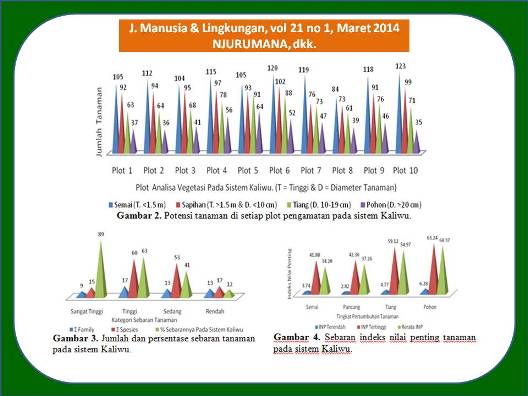
KONSERVASI KEANEKARAGAMAN HAYATI TANAMAN PADA SISTEM KALIWU DI PULAU SUMBA (Plant Biodiversity Conservation On Kaliwu System at Sumba Island)
Gerson N. Njurumana(1*), Djoko Marsono(2), Irham Irham(3), Ronggo Sadono(4)
(1) Balai Penelitian Kehutanan Kupang, Jl. Untung Suropati No. 7, Po.Box. 67 Kupang NTT 85115
(2) Fakultas Kehutanan, Universitas Gadjah Mada, Bulaksumur, Yogyakarta 55281
(3) Fakultas Pertanian, Universitas Gadjah Mada, Kompleks Agro Bulaksumur, Yogyakarta 55281
(4) Fakultas Kehutanan, Universitas Gadjah Mada, Bulaksumur, Yogyakarta 55281
(*) Corresponding Author
Abstract
ABSTRAK
Konservasi keanekaragaman hayati tanaman di lahan rakyat memiliki peluang strategis mendorong masyarakat melakukan konservasinya, karena akumulasi lahan rakyat lebih luas dibandingkan dengan kawasan konservasi alam yang tersedia. Oleh karena itu, diperlukan pemahaman mengenai sudut pandang masyarakat dan penerapannya dalam konservasi keanekaragaman hayati tanaman, yang tercermin pada berbagai bentuk dan sistem pengelolaannya oleh masyarakat. Penelitian bertujuan mengetahui sudut pandang masyarakat terhadap keanekaragaman hayati tanaman, dan penerapannya melalui pengelolaan sistem Kaliwu di Pulau Sumba. Hasil penelitian menunjukkan, bahwa pemahaman masyarakat terhadap keanekaragaman hayati tanaman sangat komprehensif, karena nilai dan manfaatnya menyentuh aspek-aspek kehidupan masyarakat yaitu aspek ekonomi-pendapatan, aspek ekologi-konservasi, aspek sosial-budaya dan aspek spiritual. Manifestasi dari sudut pandang masyarakat diterapkan melalui pengelolaan keanekaragaman hayati tanaman pada sistem Kaliwu yang mencapai 145 spesies, termasuk spesies terancam punah dan langka yang berasal dari 52 Famili. Nilai dan prinsip dasar dari konservasi keanekaragaman hayati tanaman oleh masyarakat pada sistem Kaliwu bersimpul pada keselarasan dan keberlanjutan antara kegiatan pemanfaatan dan konservasinya.
ABSTRACT
Plant biodiversity conservation on communities land has a strategic opportunity in encouraging community to carry out plant conservation due to the higher accumulation of people’s land compared to the conservation area available. Therefore, understanding is required on the community perspective and its implementation in the plant biodiversity conservation shown in the various managerial forms and systems that the community performs. This research aimed to identify the community perspective on plant biodiversity and its implementation through the management of Kaliwu system at Sumba Island. The results shows that community understanding on plant biodiversity is highly comprehensive since its values and benefits have reached the community life aspects including economic-income, ecological-conservation, socio-cultural and spiritual aspects. Based on the community perspective, manifestation is implemented through the plant biodiversity management in the Kaliwu system of 145 species, including endangered and rare species from 52 families. The basic values and principles of plant biodiversity conservation that the community has conducted on the Kaliwu system are based on the harmony and sustainability between utilization and conservation.
Keywords
Full Text:
Artikel lengkap (PDF) (Bahasa Indonesia)References
Acharya U., Petheram R.J., dan Reid, R., 2004. Concepts and Perceptions of Biodiversity in Community Forestry, Nepal. Small Scale Forest Economics, Management and Policy, 3(3):401-410. BPS, 2010. Sumba Tengah Dalam Angka. Kerjasama BPS Kabupaten Sumba Barat dan BAPPEDA Kabupaten Sumba Tengah. Waikabubak. BPS, 2012. Sumba Tengah Dalam Angka. Kerjasama BPS Kabupaten Sumba Barat dan BAPPEDA Kabupaten Sumba Tengah. Waikabubak. BPS, 2012. Indikator Kesejahteraan Rakyat Sumba Tengah. Kerjasama BAPPEDA Kabupaten Sumba Tengah dan BPS Kabupaten Sumba Barat. Waikabubak. Charnley S., Fischer, A.P., dan Jones, E.T., 2007. Integrating Traditional and Local Ecological Knowledge into Forest Biodiversity Conservation in the Pacific Northwest. Forest Ecol. & Manag.246:14-28. Dombois, D.M dan Ellenberg, H., 1974. Aim and Methods of Vegetation Ecology. John Willey & Sons. Toronto. Frison E.A., Smith, I.F., Johns, T., Cherfas, J., dan Eyzaguirre, P., 2006. Agricultural Biodiversity, Nutrition and Health : Making Difference to Hunger and Nutrition in the Developing World. Food & Nutri. Bull. 27:167-179. Indrawan M., Primack, R.B., dan Supriatna, J., 2007. Biologi Konservasi (Edisi Revisi). Yayasan Obor Indonesia. Jakarta. Mace G.M., Norris, K. dan Fitter, A.H., 2012. Biodiversity and Ecosystem Services : A Multilayered Relationship. Trends Ecol. & Evol. 27(1):19-26. Marsono, D., 2004. Konservasi Sumberdaya Alam dan Lingkungan Hidup. BIGRAF Publishing bekerjasama dengan Sekolah Tinggi Teknik Lingkungan (STTL) Yogyakarta. Yogyakarta. Nesbitt M., R.P.H. McBurney, M. Broin dan H.J. Beentje. 2010. Linking Biodiversity, Food and Nutrition: The Importance of Plant Identification and Nomenclature. Food Compos. & Anal. 23:486-498. Polunin, N., 1994. Pengantar Geografi Tanaman dan Beberapa Ilmu Serumpun. Gadjah Mada University Press. Yogyakarta. Ramakrishnan, P.S., 2007. Traditional Forest Knowledge and Sustainable Forestry : A North-East India Perspective. Forest Ecol. & Manag. 249:91-99. Robinson D.A., Hockley, N., Cooper, D.M., Emmett, B.A., Keith, A.M., Lebron, I., Reynolds, B., Tiping, E., Tye, A.M., Watts, C.W., Whalley, W.R., Black, H.I.J., Warren, G.P., dan Robinson,J.S., 2013. Natural Capital and Ecosystem Services, Developing an Appropriate Soils Framework as a Basis for Valuation. Soil Biol. & Biochem. 57:1023-1033. Vel, J., 2010. Ekonomi-Uma : Penerapan adat dalam dinamika ekonomi berbasis kekerabatan. (judul asli : The Uma-Economy: Indigenous economics and development work in Lawonda, Sumba (Eastern Indonesia). Alih bahasa oleh Myrne Tehubijuluw-Umboh. Ed.1. HuMa; Vollenhoven Institute; KITLV. Jakarta. Walters J.L., dan Mulder, I., 2009. Valuing Nature, the Economics of Biodiversity. Nature Conser. 17:245-247.
Article Metrics
Refbacks
- There are currently no refbacks.
Copyright (c) 2017 Jurnal Manusia dan Lingkungan







